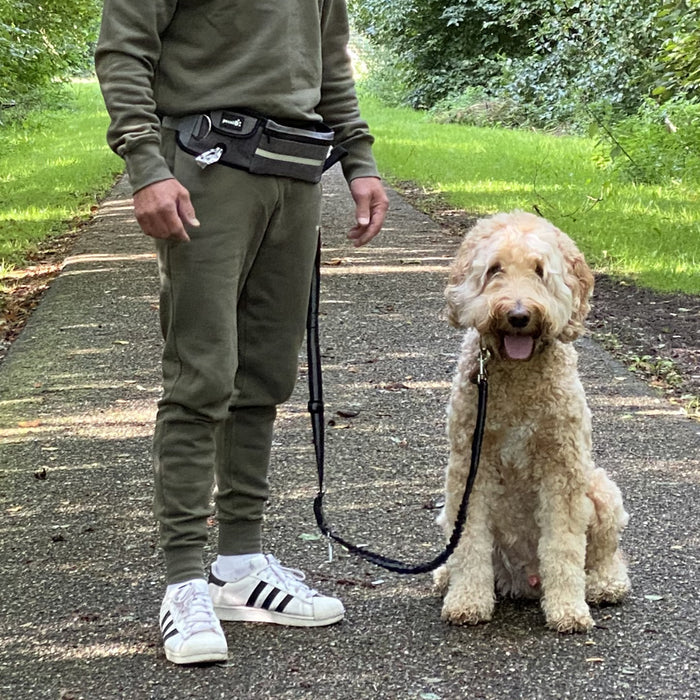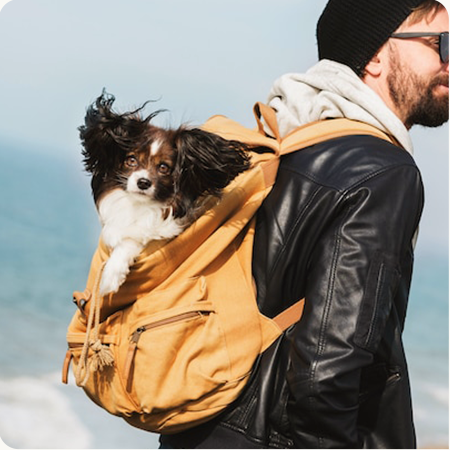Winter holidays are especially exciting, complete with sparkly lights, delicate ornaments, and brightly colored garlands. All of these things are great fun for us, but they’re also intriguing to our pets.
Putting up a Christmas tree is one of the best parts, and dogs agree. So, before you set up the tree and start lining up the decorations, take a few minutes to consider these Christmas tree safety tips for dogs.
Dog Christmas Tree Safety Tips
It can be very difficult to keep a young puppy away from the Christmas tree, particularly if this is their first Christmas. Even for an older dog, who may have learned not to jump on the tree, you will still need to be cautious.
Here are a few pet safety hazards along with some precautions you can take.
Branches and Needles
A live tree can be especially hazardous. Dogs like to chew on the limbs, and the fir tree oils can be irritating to the mouth tissue, causing such symptoms as drooling and vomiting. Also, if your pet is chewing on the branches, there is a good chance they are also swallowing some of the needles.
When ingested, pine needles can get caught in the intestinal tract, puncturing the lining or bunching together and causing an intestinal obstruction. Both can have deadly consequences. You should be careful with artificial trees as well, because they can cause the same kind of obstruction, and pets are likely to chew those crunchy needles, too.
The best solution is limiting your dog's access to the area where you are setting up your Christmas tree. In some cases, this can be achieved with a fence or pen that surrounds the tree.
Flocking
A popular tree decoration called flocking, or imitation snow, can also cause serious problems when significant amounts of it are swallowed. If you are going to have a tree in your home, it is best to at least get a non-flocked tree.
Christmas Tree Preservatives
In addition, some trees are treated with chemical preservatives to keep them fresh longer. These chemicals leach into the water in the tree base, making the water poisonous to drink. And dogs will definitely drink the water if the base is left uncovered. You can cover it with a festive tree skirt, or you can use a towel, plastic wrap or aluminum foil.
Christmas Tree Lights
Christmas lights should be positioned away from the very bottom of the tree, unless you are sure that your pet has been successfully trained not to chew on the cords. Electric cord injuries are very damaging to the mouth tissue and can lead to long-term problems with eating, amongst other issues, including difficulty breathing and death. Check the electric light cords frequently for signs of chewing (also a fire hazard).
Ornaments
Hang your delicate and most treasured ornaments on the uppermost branches of the tree, and secure them to the branches tightly. In general, it is easier on the whole household if you select tree ornaments that are not likely to shatter.
For delicate glass or priceless ornaments, you might consider creating an area where they can be displayed that is out of reach of your dog's tail or mouth. You can hang these from a garland that is placed across a mantel or over a doorway or window, or you can hang them in shadowboxes on the wall, for example.
Tinsel
Tinsel, for all its glittery prettiness, is one of the most dangerous tree decorations you can choose. If your pet ingests even a few strands of tinsel—and pets do this more often than you might guess—they are highly likely to suffer the ill, and even deadly effects, of an intestinal obstruction.
The same goes for edible ornaments, such as popcorn and cranberry strings and candy canes. The strings can tear the intestines, endangering your pet’s life. Leave these things off your tree, or your dog will be jumping on the tree to get to them.
Other tree decorations that can be hazardous to dogs (and children, for that matter) include angel hair, a spun glass or plastic decoration; garlands; lit candles; mistletoe; poinsettia plants and holly berries; advent calendars that hold candy (often chocolate); and liquid potpourri, which can be spilled or ingested.
When you can rest in the knowledge that you have done everything to make sure your pet cannot be harmed, then everyone can share in a happy, healthy holiday season together.


